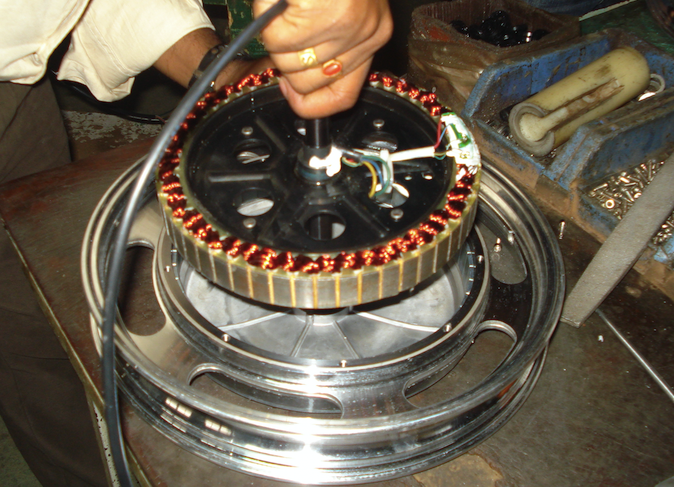Everybody recognizes that if you can make very efficient electric motors, you can make a quantum leap forward. – James Dyson
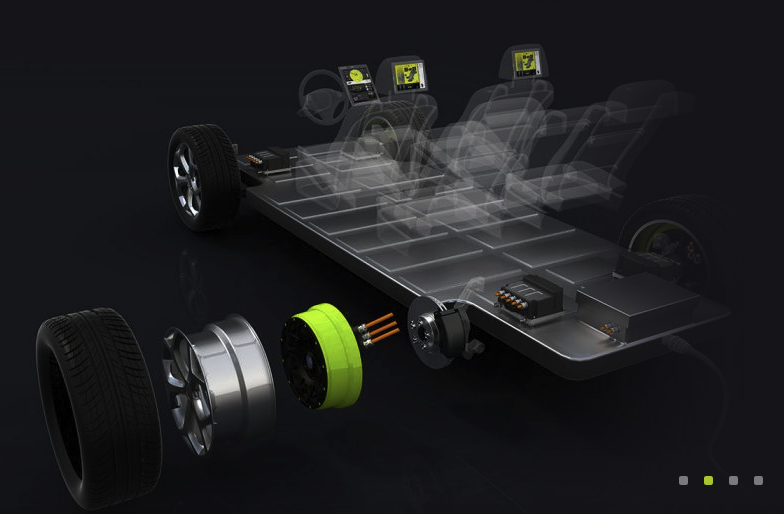
We know we use electric motors in all formats of electric vehicles. There are motors with gearing and transmission system and also motors which Hub motors directly fitting to the wheel. In this article, we will talk about the Brushless dc hub motors which are most widely used in electric bikes around the world and now moving its impact towards larger format EVs like electric cars, e-buses and e-trucks. In this article series on hub motors, I would share information about the introduction, technical aspects, manufacturing process, application-oriented topics. This article gives an introduction and its impact on the global electric vehicle business. My apologies for being more technical in the articles, I will try to elaborate the concepts in a simple manner.
What is hub motor?
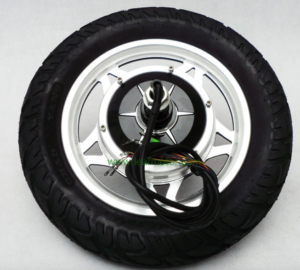 Hub motor, which is also called wheel hub motor, wheel motor, wheel hub drive and also in-wheel motor. It is an electric motor that is incorporated into the hub of the wheel and drives it directly. The motor technology used in this motor is brushless dc technology. Brushless dc ( BLDC ) motor is the next generation of DC motor technology where the mechanical commutation is replaced with electronic commutation. This removes all the contacts between rotor and stator and gives a longer life for the motor. Use of BLDC Motor technology helps to improve the power density of a motor. i.e. For the same power rating, BLDC Motor will be smaller than DC Motor. This scaling up of the power density is attainted by usage of Neodymium Iron Boron magnets. Let us limit the details of BLDC for now and talk more about the hub motors.
Hub motor, which is also called wheel hub motor, wheel motor, wheel hub drive and also in-wheel motor. It is an electric motor that is incorporated into the hub of the wheel and drives it directly. The motor technology used in this motor is brushless dc technology. Brushless dc ( BLDC ) motor is the next generation of DC motor technology where the mechanical commutation is replaced with electronic commutation. This removes all the contacts between rotor and stator and gives a longer life for the motor. Use of BLDC Motor technology helps to improve the power density of a motor. i.e. For the same power rating, BLDC Motor will be smaller than DC Motor. This scaling up of the power density is attainted by usage of Neodymium Iron Boron magnets. Let us limit the details of BLDC for now and talk more about the hub motors.
What are the applications hub motors are been used currently in the market?
Electric Unicycles
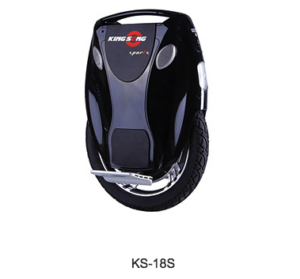
Electric unicycle is becoming prominent in the personal transportation sector, where one can just carry it using a backpack bag and helping to solve the last mile transportation. An electric unicycle (EUC) is a one-wheel scooter which is normally used for personal transportation especially commuting and leisure. A self-balancing electric unicycle is usually made up of one wheel instead of two wheels.
Motor power starting from 200W till few thousands of watts. These vehicles use hub motors with the pressure sensor which drives the motor based on the rider foot pressure signals. They’re faster, have better range and can take more weight when compared to their counterparts hoverboards.
Electric bikes
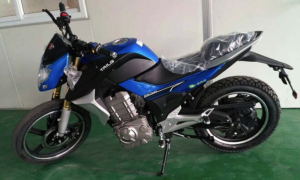
Nowadays we can’t imagine an electric bike without hub motor. China is the largest producer of electric bikes because of their technical know-how in BLDC, permanent magnet and manufacturing technology. Hub motors for electric bikes range from 250W till 7000W. Uumotor has a hub motor of 7kw with a 13-inch wheel and gives a torque of 200N. The wheel can attain a top speed of 120 kmph and can climb a 25 deg. slope
The hub motors are aluminium die-casted parts, using neodymium iron boron magnets. The motor is always accompanied by a power electronic controller which acts as the electronic commutator. The die-casted cover design depends on the vehicle model if it is for an electric scooter or for an electric cycle. If it is for the electric cycle, the cover should have a provision for inserting spokes too.
India has a power limit of 250W for road tax and driving licence exemption. Because of the reasons stated above, hub motor has proven itself as the strong contender for electric bike application.
Electric car, trucks and buses
Electric cars have always been driven by motor and transmission system but the in-wheel motors are gaining prominence for electric car category.Though there are several concept cars incorporated in-wheel hub motor for their application, still these EVs are not yet commercially available yet. GM’s Sequel, Protean Electric’s Mini QED,
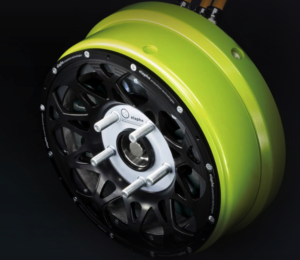
Mitsubishi MIEV, Citroën C-Métisse used in-wheel hub motors for their concept vehicles displayed in various automobile exhibitions. Companies like Elaphe, Barbus, ZAwheel, TM4 already started making in-wheel hub motors for heavy electric vehicles.
The Protean drive is a 75-pound electric motor that generates 100 HP and 735 lb-ft of peak torque. The motor does not require external gearing, drive shafts, or differentials. The motor package, which contains an inverter, control electronics, and software, fits easily in the unused space behind a conventional 18 to 24 inch.
Brushless dc hub motor working mechanism
This is an external rotor motor, where the outside will be rotated. The tire seats on the outer side which make it a direct drive. That means the speed on the motor is same as speed on the road. The rotor has NdFeB magnets glued and the stator is winded as per the required torque and speed. BLDC Motor is like a synchronous motor where the rotor tries to catch up the rotating stator electromagnetic field resulting due to continuous switching of phases by the power electronic controller. Hub motor is used in high torque and low-speed applications. Due to the high torque, this finds suitable for electric vehicles as EVs needs a high starting torque. Due to the low operating speed of the motor, cogging is observed which increases the torque ripple in the motor which is not a good condition.
What are the advantages and disadvantages of hub motors?
Like any other technology, Hub motors have its own advantages and disadvantages too. Let us discuss them in details
Advantages
- As they are directly incorporated to hub motor the vehicle, it is simple and easy to install. This feature helps us to easily convert any existing bike/bicycle to an electric bike. This is why these motors are mostly preferred for conversion kits.

- If using a hub motor, the vehicle no needs a differential.
- These motors are outside rotor motors. They have a 1:1 motor ratio. Every time the motor does one revolution so does the wheel.
- Hub motors design has more magnetic poles, which means the motor gives a higher torque. A higher torque is critical for the initial start of the vehicle.
- As the hub motors used BLDC Motor technology, which has electronic commutation instead of mechanical commutation. Hence this motor needs very less maintenance compared to its counterparts and more reliable.
- Hub motors are free from any kind of gears or chain transmission which increases the operating efficiency of the vehicle compared to its counterparts. In addition, the absence of the transmission parts means no need use any oil which may contaminate the product.
- An important advantage is the motors are quiet while operating and will give a pleasant ride.
Disadvantages
- Hub motors are adding weight to the wheel. Unsprung weight is all bad. Unsprung weight includes the mass of tires, brakes, suspension linkages and other components that move along with wheels. These components react to roadway irregularities with no damping. Rest of the mass is on the vehicle side of the springs is the sprung weight. Disturbances from the road are filtered by the suspension system and as a result, are not fully experienced by sprung weight. The ratio of the sprung and unsprung weight is one of the most important components of the vehicle ride and handling. In general, a 1kw hub motor weights around 8~10kg and this weight add to the wheel weight. If hub motor is considered for the electric car or electric bus, the unsprung weight will be even more.
- Hub motors use the high number of magnets which means their operating speed is less which is around 300 ~ 500 rpm based on the wheel size and application. Low operating speed has a risk of motor cogging torque.Cogging torque of electric motors is the [torque] due to the interaction between the permanent magnets of the rotor and the stator slots of a Permanent Magnet (PM) machine.It is especially prominent at lower speeds, with the symptom of jerkiness. Cogging torque is an undesirable component of the operation of such a motor. Cogging torque results in torque as well as speed ripple; however, at high speed the motor moment of inertia filters out the effect of cogging torque.
- As the motor is in the wheel, the electrical connections must be between the wheel and the body making the harness connections more complex, stressed and increases the risk of fire hazards.
- Hub motors are still not waterproof due to the application. As they are fitted on to the wheel, there must be a clearance on both side covers leading to the leakage. My experience while manufacturing these motors, a lot of customer complaints are due to water entry and damaging the hall sensors circuit and the motor was not running due to this.
- Motor cooling is always an issue because of the hub motor configuration. The outer rotor configuration doesn’t suit for water cooling and forced to use natural cooling which might get impacted on the motor reliability. Permanent magnets performance also depends on the operating temperature.
My thoughts on how the Hub motors can get the lion’s share of EV market
Hub motors have both advantages and disadvantages but we can see the advantages outweigh the disadvantages. This proves there is a lot of potential for this configuration to be used in EVs but there should a strong R&D effort to make sure the design able to withstand the mechanical, thermal and electrical stress to the motor while on road. Critical aspects should be proper motor cooling and vehicle design for lesser unsprung mass. The selling point for this technology would be high torque, low active weight, high efficiency, efficient cooling, high level of integration capability and especially low manufacturing costs
Stay tuned for Hub motor manufacturing process and more articles
If any suggestions or questions, Don’t hesitate to message me on any of the below social media sites, I would answer you soon.
Twitter – @umkev
Facebook – @murali.today
Instagram – @umkev
Weibo – @umkev
Note: The article is totally my own thoughts and not necessarily anyone needs to agree with my thoughts and ideas.
